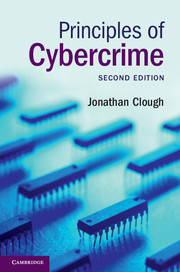Book contents
- Frontmatter
- Contents
- Preface
- Acknowledgements
- Table of Legislation
- Table of Cases
- List of abbreviations
- Part I Introduction
- Part II Computer as target
- 2 Computer as target
- 3 Access offences
- 4 Modification or impairment of data
- 5 Misuse of devices
- 6 Interception of data
- Part III Fraud and related offences
- Part IV Content-related offences
- Part V Offences against the person
- Part VI Jurisdiction
- Bibliography
- Index
4 - Modification or impairment of data
from Part II - Computer as target
Published online by Cambridge University Press: 05 October 2015
- Frontmatter
- Contents
- Preface
- Acknowledgements
- Table of Legislation
- Table of Cases
- List of abbreviations
- Part I Introduction
- Part II Computer as target
- 2 Computer as target
- 3 Access offences
- 4 Modification or impairment of data
- 5 Misuse of devices
- 6 Interception of data
- Part III Fraud and related offences
- Part IV Content-related offences
- Part V Offences against the person
- Part VI Jurisdiction
- Bibliography
- Index
Summary
Introduction
The previous chapter was concerned with those offences which punish access to data. In this chapter, we look at those situations where the defendant interferes with the data in some way. In the past, such conduct was prosecuted, with some success, as criminal damage. However, criminal damage does not fully encompass the range of conduct which may arise in this context, and is based on notions of property, the application of which to data was often ‘more ingenious than practical’. Accordingly, each jurisdiction has specific offences concerned with the modification or impairment of data.
Such offences are encompassed by Articles 4 and 5 of the Cybercrime Convention, relating to data and system interference respectively. ‘Data interference’ offences are those which relate to the intentional and without right ‘damaging, deletion, deterioration, alteration or suppression of computer data’. These offences are intended to protect computer data from intentional damage, protecting the ‘integrity and the proper functioning or use of stored computer data or computer programs’. Of course, simply executing a program will cause an alteration of data. Accordingly, the Convention allows parties to reserve the right to require that the conduct resulted in serious harm before such conduct is criminalised.
While Art. 4 is concerned with intentional damage to the data itself, Art. 5 relates to ‘system interference’ where there is the intentional and without right ‘serious hindering … of the functioning of a computer system by inputting, transmitting, damaging, deleting, deteriorating, altering or suppressing computer data’. Although hindering the functioning of a computer system will commonly occur due to modification of data, it may also occur where there is no modification of data but access to the computer is prevented or its functioning restricted; for example, a DoS attack. Hence, these offences apply to intentionally hindering the use of a computer system (which includes telecommunications facilities) by ‘using or influencing’ computer data.
Although similar in rationale to offences of criminal damage, it is important that a distinction be maintained between physical damage to a computer and damage caused by the operation of a computer. Further, there is a strong argument for parity between penalties for physical damage and those for impairment of data.
- Type
- Chapter
- Information
- Principles of Cybercrime , pp. 112 - 132Publisher: Cambridge University PressPrint publication year: 2015



